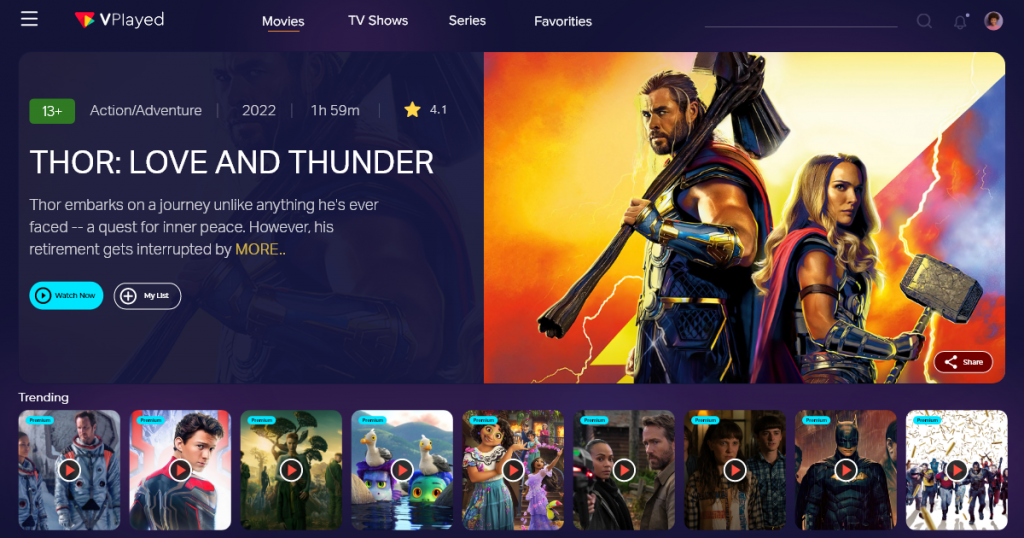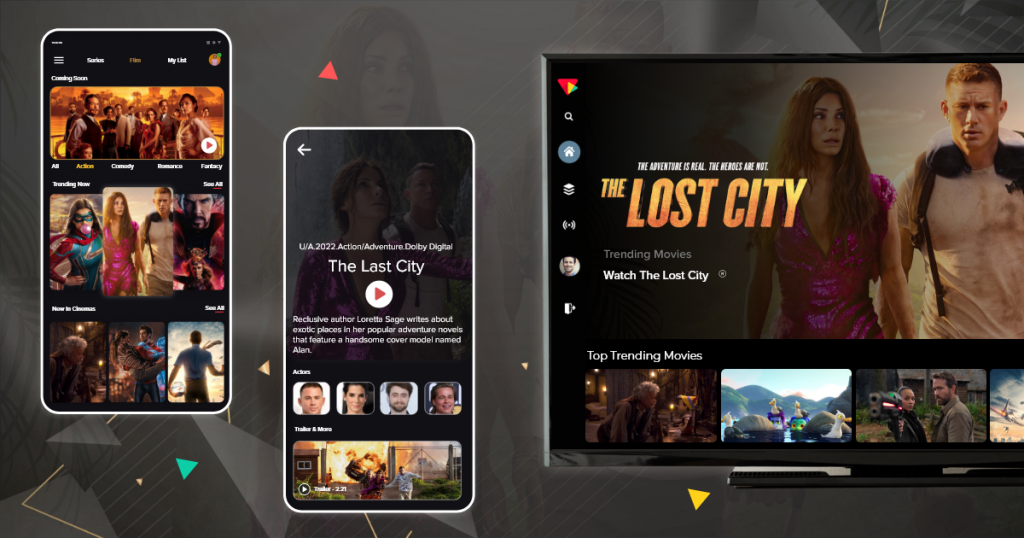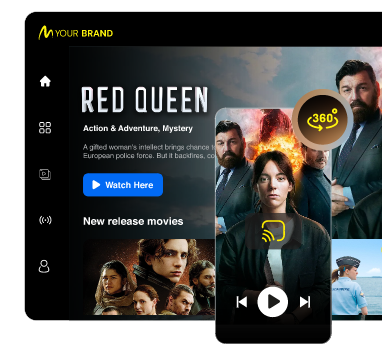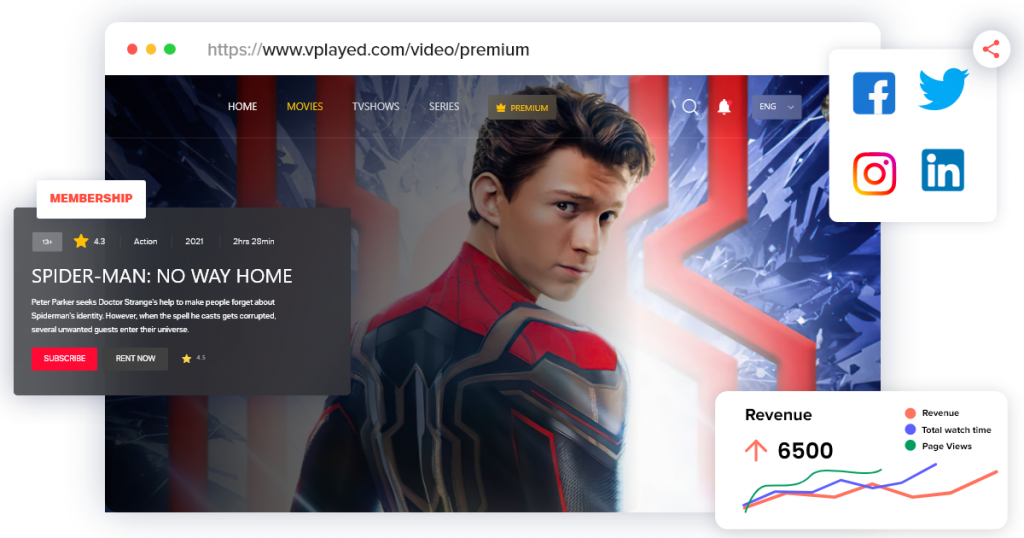Start and Grow Your VOD Streaming Platform With 1000+ Features & 10+ Revenue Models.
Book a Free DemoHow to Build a Billion-Dollar Video On Demand (VOD) Website?

Looking to build a VOD website that actually brings in revenue and grows with your audience?
Then you are on the right track.
A well-built video-on-demand website not only entertains but also leads to business growth, brand visibility, and recurring income.
With global VOD revenue projected to hit a whopping $786.10 billion by 2032, there has never been a better time to carve out your space in the VOD streaming industry.
Platforms like Netflix and Amazon Prime are no longer the only players; businesses of all sizes are entering the video on demand space and winning big.
By launching your own VOD website, you build more than a business; you build a brand for yourself. One that owns its content, engages its audience, and monetizes without platform fees eating into your profits.
In this blog, we will walk you through how to create a VOD website from scratch, what features matter, the tech stack behind it, monetization models, costs, and everything in between.
- Fully Customizable
- Lifetime Ownership
- On-Premise/On-Cloud
- 100% White-label
- Zero Revenue Share
- Hire Dedicated Developers
Table of Contents
✅What is a VOD Platform?
A Video-on-Demand platform is a digital system that lets users watch content anytime they want, choose exactly what they want to watch, control playback with pause, rewind, or fast-forward features.
Unlike traditional TV with fixed schedules, a VOD platform gives viewers the ability to stream content on their own terms. Here, the content denotes movies, tutorials, niche series, etc.
For businesses and content creators, building a VOD platform means venturing into new revenue streams, reaching global audiences, and having complete control over everything (branding, monetization, user experience, etc)
✅How to Build the Best Video On Demand Website? -The 10 Step Guide
This 10-step guide to creating a VOD website walks you through selecting the right tech stack, setting up monetization models, securing your content, and delivering a great user experience; everything you need to successfully launch, grow, and monetize your own VOD website.

👉1. Choose a Scalable VOD Hosting Infrastructure
Before anything else, selecting a VOD hosting provider is foundational. Look for one offering cloud-native infrastructure, generous storage limits, and a global CDN for low-latency video delivery.
The platform should support adaptive bitrate streaming, video ingestion, cross-device compatibility and live streaming (if possible)
Also, prioritize solutions that provide a central CMS, support for custom APIs, and flexible deployment models (cloud, on-premise, or hybrid) to align with your compliance and operational standards.
Beyond core tech, ensure the provider enables future growth. Features like third party integrations, robust analytics, and regular platform updates help keep your VOD business agile.
Evaluate the SLA (Service Level Agreement) for uptime guarantees, the ease of content migration, and the scalability of the stack. A platform that grows with you not limits you will be your most valuable long-term asset.
👉2. Define Niche and Audience Segmentation
To build a high-converting VOD website, it is important to clearly define your audience. Go beyond basic demographics; explore psychographics, content consumption behavior, time zones, and preferred devices.
This level of granularity helps in organizing your video catalog, designing your UI/UX, and creating segmented marketing campaigns that actually convert.
Use industry reports, viewer feedback, and competitor analysis to know niche gaps that you can uniquely fill. Next, implement behavior-driven segmentation.
Develop distinct user personas and conduct A/B tests to determine which content types, formats, and pricing models go well with each group.
Tools like heatmaps, clickstream tracking, and session replays allow you to fine-tune user journeys and engagement points.
The end goal? A highly personalized platform experience that increases watch time, retention, and revenue.
👉3. Map User Journey and Optimize UX Design
User Experience (UX) begins with a deep understanding of the user’s journey; from landing on your homepage to completing a binge session.
A frictionless flow should cover smart navigation, low video load times, smart content discoverability, and consistent functionality across all devices.
Design a UI that offers features like multilingual support, currency localization, personalized content feeds, smart search, and user-generated watchlists. These small optimizations can drastically improve engagement and retention.
Once the journey is mapped, implement your design using frontend frameworks like React for dynamic and fast-loading interfaces.
Combine wireframing tools with A/B testing to test layout hypotheses before full-scale rollout. For mobile apps, integrate native SDKs to ensure smooth playback and real-time sync across devices.
Make sure your platform is WCAG-compliant to meet accessibility standards. Finally, embed micro-interactions, visual feedback, and gamified elements to create a rewarding experience.
👉4. Integrate Real-Time and Predictive Analytics
Analytics is the feedback engine of your VOD business. Start by integrating real-time dashboards to track vital metrics like watch time, click-through rates (CTR), bounce rates, and drop-off moments.
These KPIs help you respond quickly, whether by swapping thumbnails, fixing broken flows, or spotlighting underperforming videos.
To stay ahead, implement predictive analytics that identify upcoming content trends, user churn risks, and lifetime value.
Use tools like Mixpanel, Amplitude, or platform-native dashboards for funnel visualization and cohort tracking. Going deeper, apply AI/ML models to extract sentiment insights from social media, app reviews, and support logs.
This multi-layered data stack enables you to optimize content planning, monetization, and retention, before problems surface.
👉5. Select a Revenue Strategy That Fits Perfectly
Choosing the right monetization model isn’t just about revenue, it is about aligning with user intent and content lifecycle.
Common VOD business model include:
- SVOD (Subscription): Best for long-form content and series
- TVOD (Transactional): Ideal for one-off premium content
- AVOD (Ad-Supported): Effective for wide reach and free content
- Hybrid: Combine multiple models for maximum ROI
To maximize revenue potential, offer freemium trials or discount codes. Implement tier-based subscriptions video on demand that vary by video quality, concurrent streams, or early-access perks.
Modern VOD websites also allow dynamic pricing and region-based plans via smart billing APIs. On the B2B front, consider white-labeling, custom licensing, or content packages.
Back it all with analytics to monitor ARPU (Average Revenue Per User), conversion funnels, and churn triggers so your monetization adapts as fast as your users do.
👉6. Implement Content Security Protocols
In 2025, building a VOD website with robust content protection isn’t just a feature, it is a requirement to gain content licensing rights and user trust.
Begin with Multi-DRM integration (Widevine, FairPlay, PlayReady) and AES-256 encryption to safeguard content at rest and in transit.
Pair this with SSL certificates and HTTPS/RTMPS protocols to ensure secure delivery across all devices.
To prevent unauthorized access, use secure CDN tokens, session-based playback tokens, and geo-restrictions.
Add dynamic watermarking to trace piracy sources. For real-time enforcement, integrate DDoS mitigation, anomaly detection, and automated breach alerts.
On the backend, establish a Security Operations Center (SOC) or collaborate with a managed service provider to monitor attack surfaces, access logs, and third-party vulnerabilities.
Perform regular penetration testing and code audits to patch security loopholes before they are exploited. Strong security is your platform’s moat, don’t treat it as an afterthought.
👉7. Optimize Your VOD Website for Search Engines
SEO is the backbone of sustainable user acquisition. Optimize each video asset with proper metadata, keyword-rich titles, schema markups, tags, and detailed descriptions.
Add transcripts and subtitles to make content accessible and indexable by search engines. Create and regularly update XML sitemaps to ensure proper indexing.
Structured data also enhances rich snippets and video carousel placements on Google. Beyond individual video optimization, focus on platform-wide SEO architecture. Use canonical URLs, consistent internal linking, and mobile-friendly layouts.
Create a blog or learning hub to establish topical authority and generate backlinks. Integrate lead capture forms within content or at exit points to convert organic views into qualified leads.
Employ AI tools to generate metadata, summarize content, and recommend keywords at scale. Technical SEO combined with content quality positions your VOD website as a trusted content destination.
👉8. Implement Omnichannel Marketing
Once you finish building a VOD website, marketing your platform should follow a full-funnel omnichannel strategy.
For top-of-the-funnel outreach, run targeted awareness campaigns via social media reels, teaser trailers on YouTube, and niche influencer collaborations.
Engage user communities through contests, AMAs, and grassroots events. Use editorial calendars to maintain consistency in newsletters, YouTube promotions, and blog outreach.
In the conversion phase, deploy retargeting ads, automated email drips, and referral programs to nudge sign-ups. Integrate with CRMs to track lifecycle stages and personalize messaging.
Use UTMs and attribution models to evaluate which channels drive ROI and adjust budgets accordingly. Don’t forget bottom-of-the-funnel tactics like push notifications, loyalty discounts, or upselling to premium plans.
Measure KPIs like CAC, LTV, churn rate, and viral coefficient to optimize marketing effectiveness. The goal is to position your VOD website not just as a content hub, but as a brand experience across digital touchpoints.
👉9. Develop and Launch Your Branded VOD Website
Once your backend and frontend modules are ready, building your VOD website requires a responsive framework that ensures consistent UI and UX across web browsers, mobile apps, smart TVs, and other connected devices.
Prioritize flawless navigation, optimized load times, and strict ADA compliance to make your platform accessible to all users.
Before going live, deploy a staging environment for thorough testing; validating functionality, integrations, and performance under simulated traffic.
Automate deployments with CI/CD pipelines to accelerate release cycles and reduce human errors. Architect your backend for elasticity to handle unpredictable traffic surges during live streams or premieres.
Implement observability through tools like Prometheus for metrics collection, Grafana for visualization, and the ELK stack for comprehensive logging and troubleshooting.
Build your VOD website using modular microservices to simplify updates and scaling. Cultivate strong DevOps practices to maintain high uptime, rapid incident response, and smooth feature rollouts.
👉10. Maintain, Measure, and Grow Continuously
Creating your VOD website is just the beginning. Establish a routine for performance audits covering server health, streaming quality, and user engagement metrics.
Set up automated monitoring to proactively detect issues before they impact viewers. Implement user feedback mechanisms like in-app polls, feature surveys, and direct reviews to gather actionable insights.
For example: If users are preferring live streaming over video on demand, then bringing in the Live to VOD functionality would help a lot to attract more people.
Utilize AI-powered recommendation engines and predictive analytics to enhance personalization and increase retention.
Use auto-scaling cloud infrastructure to handle fluctuating traffic while optimizing costs. Maintain a public changelog to build transparency and trust with your community.
Regularly conduct UI/UX audits and scalability assessments to ensure your VOD website adapts smoothly as your user base grows.
Stay informed on emerging tech trends such as AI content tagging, spatial computing, and enhanced DRM to keep your VOD offering innovative and competitive. Engage actively in niche forums and industry events to capture new ideas and user expectations.
Looking To Build Your Own VOD Platform?
Start and Grow Your Video Streaming Service With 1000+ Features & 10+ Revenue Models.
Highly Customizable
Life Time Ownership
Own 100% of Your Revenue
Full-Branding Freedom

✅How VPlayed Helps You Build Your Own VOD Website
Now that you know how to create video on demand website from scratch, here is the smarter move: let the VOD experts handle the technical stuff, while you focus on creating viral content.
Why spend months assembling a team when you can partner with VPlayed: A VOD solution provider with 16+ years of experience building custom VOD platforms for global clients.
Here is why VPlayed isn’t just another VOD solution provider, but a full-stack solution to launch, manage, and grow your video streaming business.

1. 100% Customizable Platform🏷️
No pre-built templates here. VPlayed lets you tailor every single element — from UI layouts to backend workflows; so your platform doesn’t just work; it feels like yours.
Whether you are in sports, eLearning, religious or media, it is built to fit, not force. That’s the kind of control you need when you build a VOD website that truly reflects your brand.
2. White label + Full Ownership🏷️
Your brand, your logo, your command. VPlayed offers a completely white-labeled solution with lifetime platform ownership. You control every single content, every stream, and most importantly, every dollar you earn.
3. On Cloud or On-Premise🏷️
Flexibility isn’t just a catchline here. Whether you want to deploy on the cloud or host it within your own infrastructure for more control, VPlayed supports both without compromising speed.
4. 10+ Monetization Models🏷️
SVOD, AVOD, TVOD, hybrid, pay-per-view, coupons, catch-up TV, everything is supported here. With over 10+ revenue models, you are free to experiment and optimize until you receive actual profits out of your content.
5. 150+ Integrations🏷️
From CRM and analytics tools to email marketing platforms and payment gateways, VPlayed plays well with over 150 third-party applications, helping you automate smarter & operate faster.
6. Multi-DRM & Advanced Security🏷️
As mentioned in the above section too, protecting your content is non-negotiable. With multi-DRM, AES encryption, SSL, watermarking, and geo-blocking, VPlayed ensures that your content is as secure as it is accessible.
7. HLS & HTML5 Multi-Device Player🏷️
Deliver flawless playback across every screen (mobile, tablet, web, smart TVs) with adaptive bitrate support via HLS and HTML5 video player. Fast loading, zero buffering, and crystal-clear visuals (all the time) is the kind of experience your audience expects and deserves.
8. In-built Video Marketing Tools🏷️
VPlayed doesn’t just let you stream, it helps you sell. Integrated tools like email automation, lead capture, SEO-friendly video pages, and audience segmentation take the guesswork or assumptions out of your marketing so that you can make the most out of your content.
9. VOD-Centric Analytics🏷️
Get real-time data on user behavior, content performance, monetization, and platform health. Make smarter decisions with dashboards that don’t just show numbers, but share stories.
10. Industry-Specific VOD Solutions🏷️
Targeting streamers, students, or spiritual minds? Or wanting to build an educational video subscription platform, VPlayed has ready-made modules to match your space and speed things up, so you are not starting from square one. All in all, VPlayed shortens the time it takes to build a VOD website, often launching in under 4 days.
What Would Be the Cost of Building a VOD Website in 2025?💰
Building a VOD website in 2025 is less about finding a cheap option and more about investing wisely in a platform that provides all the necessary streaming features.
But let’s tackle the big question: how much does it really cost? Short answer: It depends on how extensive and feature-rich you want your streaming infrastructure to be.
💰Basic Build vs. Full-Scale VOD Website
If you are looking at a DIY VOD website with limited branding, fixed templates, and basic features, you might get started with $5,000 to $10,000 annually, but with serious compromises in flexibility, monetization, and ownership.
On the flip side, a fully customized VOD website (complete with white-labeling, 10+ monetization models, multi-DRM, global CDN, analytics, and native apps) could range from $25,000 to $100,000+ as a one-time investment.
💰Key Factors That Influence the Cost of Building a VOD Website
- Customization Depth: The more tailored the platform (UI/UX, backend workflows, video player control), the higher the price.
- Deployment Type: On-premise deployments usually cost more than cloud-hosted ones. So, you need to choose either one according to your purpose.
- Number of Integrations: Want CRM, billing, marketing automation, third-party analytics? Every extra plug-in adds up to the cost of building a VOD website.
- Security & DRM Needs: AES encryption, watermarking, geo-blocking, and multi-DRM support aren’t optional anymore, they are a baseline for hassle-free streaming.
- Multiple Device Support: Building native apps for smart TVs, iOS, Android, and web, adds to development cost.
- Post-launch Support & Maintenance: 24/7 technical support, regular platform updates, and rollout of new features are typically covered under an annual service package.
💰One-Time vs. Recurring Cost Models
While most SaaS platforms charge you monthly or annually, often with revenue sharing involved. But, when it comes to VPlayed, it offers a one-time license fee model, helping you:
- Own the platform for life
- Avoid revenue splits whatsoever
- Save up to 75% on streaming infrastructure over time
This makes a whole lot of sense for businesses and content owners looking for long-term ROI and complete operational freedom.
✅Wrapping Up
Creating a VOD website isn’t just about streaming videos, it is about stepping into a self-sustaining ecosystem where your content builds your brand, your platform grows your revenue, and your viewers stay loyal for the long haul.
To make that a reality, we walked you through the nuts and bolts of how to build a VOD website: from choosing the right platform and monetization model to optimizing for performance, security, and scalability.
We also looked at the real cost behind launching a VOD website and why going with an experienced VOD platform provider like VPlayed could be a great decision.
The VOD market is projected to surpass $250 billion in the next few years. This is your window to ride the wave, stand out with a white-labeled platform, and stream content on your terms.
- Request Demo Book a Live, Personalized Demo
- Contact Sales Reach Out to Our OTT Experts
Build VOD Website Frequently Asked Questions (FAQ):
1. What is a Video on Demand Website?
A video on demand website is an online web space where video content like movies, TV shows, web series, etc. are demanded by viewers to consume on subscription basis.
2. How To Create A VOD Website For Your Business?
Creating a VOD website for your business is easier with the right video streaming provider, as it eases most of the development tasks and helps you reach a wider audience and to achieve monetization benefits.
3. What Are The Key Features Of A Video On Demand Platform?
The key features of a VOD platform are robust security features, flexible content management system, multiple monetization models, powerful content distribution network and simplified user interface.
How Long Does It Take To Launch A Video On Demand Website?
To launch a video on demand websites takes around 3-5 working weeks for building a Video On Demand website. But it also differs based on the project requirements, time management, budget and business needs.
5. How Much Does It Cost To Build A VOD Platform?
The average cost for building a VOD platform typically ranges from $15,000 to $30,000. The cost to build a video on demand platform depends on the features list, customization options, team necessities and additional development services.
6. What Are The Benefits Of Video On Demand For Business ?
VOD provides major benefits for businesses like extended viewership, clear-cut user interface, maximized monetization benefits and full-on security features like geographic location, IP restrictions and DRM security.
7. What Are The Best VOD Revenue Models?
As far as video on demand is concerned businesses can create and monetize their content with best VOD revenue models including subscription-based video on demand, transactional video on demand, advertising video on demand, pay- per-view catch-up TV, coupons and promotions, and video paywall.

I’ve been looking for new methods to make money off of my videos as a content creator, and video on demand looks like a fantastic solution. I feel more secure in pursuing this endeavor now that I have a better understanding of the steps involved in building a VOD website thanks to your post.
I have a niche audience in mind. Is it worth the investment in developing for a smaller user base?
This blog is fantastic! I’ve been researching how to build a VOD website, and your tips are so practical. Great work!
Hello VPlayed, I’m trying to Build a video on demand website like Netflix to help deliver on demand content. Please let me know of pricing options. Thanks!